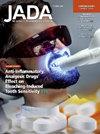Improving children’s use of care in Oregon
IF 3.5
2区 医学
Q1 DENTISTRY, ORAL SURGERY & MEDICINE
引用次数: 0
Abstract
Background
Despite lowering financial barriers to oral health care through the Patient Protection and Affordable Care Act, income-related access-to-care disparities remain, especially in Oregon. The authors examined the role of a novel dental care organization, the Willamette Dental Group (WDG), in addressing the nonfinancial barriers to oral health care that keep access-to-care disparities in place.
Methods
This longitudinal observational study used dental claims and enrollment data from the Oregon Health Plan from 2014 through 2021. The primary outcome measures were any dental visit and an examination visit. Enrollees in the Oregon Health Plan aged 0 through 18 years who were members of WDG’s Medicaid population were compared with those in the non-WDG Medicaid population. A propensity score subclassification matching method using child-, family-, and community-level variables was used to approximate a randomized study and reduce bias.
Results
The percentage of children who had any dental visit or an examination visit was significantly (P < .001) higher among the WDG members than non-WDG members. Compared with non-WDG programs, a child in the WDG program had a 40% higher chance of having any visit and a 48% higher chance of having an examination visit.
Conclusions
Children enrolled with WDG under the Oregon Health Plan experienced substantially higher oral health care use than children in non-WDG programs. Future studies should focus on the correlation of improved use with oral health outcomes at WDG.
Practical Implications
The innovative practice policies of WDG may lead the way for other large-scale dental delivery programs hoping to improve use for children enrolled in Medicaid. Future studies can benefit from the observational methodology used in this study.
改善俄勒冈州儿童护理的使用:一个新型牙科负责保健组织的作用。
背景:尽管通过患者保护和平价医疗法案降低了口腔保健的财务障碍,但与收入相关的获得保健的差距仍然存在,特别是在俄勒冈州。作者研究了一个新的牙科保健组织,威拉米特牙科集团(WDG)在解决口腔保健的非经济障碍方面的作用,这些障碍使获得护理的差距保持在适当的位置。方法:这项纵向观察研究使用了2014年至2021年俄勒冈健康计划的牙科索赔和登记数据。主要结果测量是任何牙科就诊和检查就诊。俄勒冈健康计划0至18岁的WDG医疗补助人群参保者与非WDG医疗补助人群参保者进行比较。使用儿童、家庭和社区水平变量的倾向评分亚分类匹配方法来近似随机研究并减少偏倚。结果:WDG成员儿童进行牙科检查或检查的比例显著高于非WDG成员(P < 0.001)。与非WDG项目相比,WDG项目中的儿童接受任何访问的机会高出40%,接受检查访问的机会高出48%。结论:在俄勒冈健康计划下参加WDG计划的儿童比参加非WDG计划的儿童有更高的口腔保健使用率。未来的研究应侧重于改善使用与WDG口腔健康结果的相关性。实际意义:WDG的创新实践政策可能会引领其他大规模牙科交付项目,希望改善医疗补助儿童的使用。未来的研究可以从本研究中使用的观察方法中受益。
本文章由计算机程序翻译,如有差异,请以英文原文为准。
求助全文
约1分钟内获得全文
求助全文
来源期刊

Journal of the American Dental Association
医学-牙科与口腔外科
CiteScore
5.30
自引率
10.30%
发文量
221
审稿时长
34 days
期刊介绍:
There is not a single source or solution to help dentists in their quest for lifelong learning, improving dental practice, and dental well-being. JADA+, along with The Journal of the American Dental Association, is striving to do just that, bringing together practical content covering dentistry topics and procedures to help dentists—both general dentists and specialists—provide better patient care and improve oral health and well-being. This is a work in progress; as we add more content, covering more topics of interest, it will continue to expand, becoming an ever-more essential source of oral health knowledge.
 求助内容:
求助内容: 应助结果提醒方式:
应助结果提醒方式:


